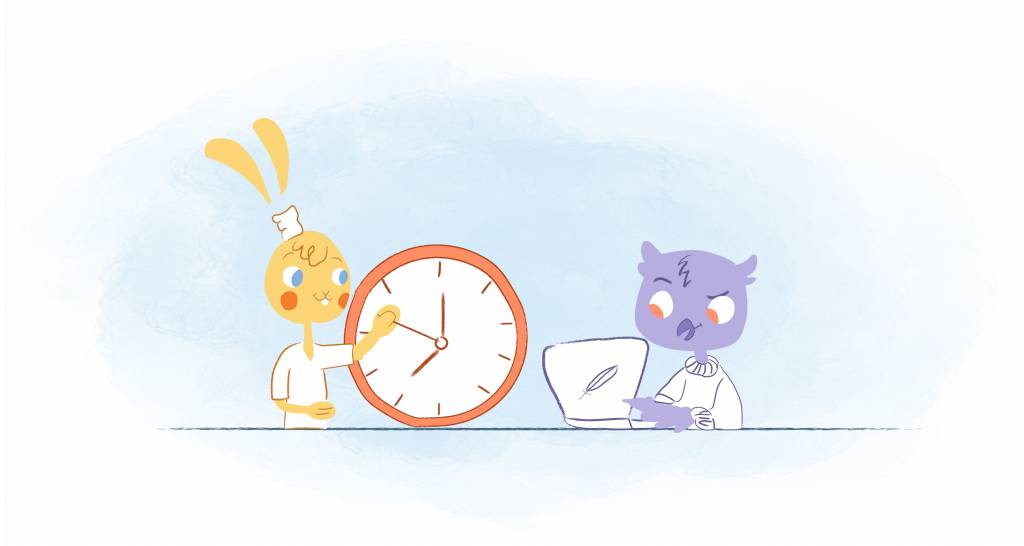

At the time of this writing, it’s spring. So, I’ve been spending as much time as I can outside. A few ways to spend a great time outside are by tinkering with a vegetable garden, playing with your kids, riding your bike, or getting in shape.
Now, unless you’re oblivious, fruits and veggies don’t just magically grow. You need to work the soil, plant the seeds in a well lite area, and water your plants if you want a bountiful harvest. Likewise, kids don’t just magically learn things. You need to work with your kids, send them to school, and spend time teaching your kids, and magically getting in shape remains elusive.
It may not seem like it. But the same is true with time management.
As with a garden, kids, getting in shape, and job improvement — time management is all about being deliberate. Being deliberate means carefully thinking or talking something through. Deliberation also means the pace and method of making such a decision.
Again, you just can’t throw seeds wherever you want, expecting them to thrive. That’s also true with you managing your time. It requires commitment, focus, and being mindful of your daily decisions.
When you’re deliberate with time, you’ll yield the results you want. That could be achieving your goals or spending time where you want to. You’ll also have less stress and anxiety. And, just like a garden, you’ll have an abundance of growth opportunities.
But, how can you be more deliberate with your time management skills? Well, here are the strategies that have worked best for me.
Start with small blocks of intention.
“You’re not going to magically transform into a master of intentionality, intentionally spending every second of your day,” writes Leo Babauta of Zen Habits.
“Instead, you’re going to pick a small block of time and practice,” he adds. He suggests practicing for two short blocks of time at a time. Then keep going.
Let’s begin with a few questions:
- What would be the most important and loving thing you could do with 30 minutes of your time each day?
- If you could only do one thing today and be satisfied with that — what would it be?
“You want to think of the one thing you could do that would change your life somehow,” he suggests. In Leo’s case, it’s either writing this post or creating a new course. Meditation might motivate you, or you might start that non-profit you’ve wanted to establish. Perhaps you’d like to create T-shirts or videos. Maybe you’d like to finally organize your finances.
You don’t want to overwhelm yourself here. Just choose one activity that would have the most impact.
“Then set up an intentional block of time at the beginning of each day and spend it on this one activity,” adds Leo. “For example, if I want to write every day, I’ll set up a writing block of 30-60 minutes at the start of every day — before email and messaging and checking websites.”
You could dedicate a block every day to get you closer to one of your goals.


Get Closer to Your Goal With Time Management and Your Calendar. Image Credit: by Thegiansepillo; Pexels; Thanks.
Guidelines for your intentional behavior.
- Pause and decide beforehand what you’re going to do. Make an intention during these 30 minutes, and don’t just drift along with the currents of your online life.
- Know your Why. Why is this important to you? Is it to help someone else, a group of people, the world? Is this an act of love for yourself or others? Keep this Why in mind while you complete your activity.
- Notice your tendency to rush through. This may be due to your desire to get the job done. After all, it’s how most people operate. Be present in your activities instead of rushing through them.
- Try falling in love with the activity. What if you could live in the moment, with what’s there, with whatever you’re doing, instead of simply going through the motions?
- Don’t let yourself be distracted. After starting something, we tend to switch to another task almost immediately. Put aside everything else and focus solely on this activity.
Priotize — and priotize again.
Effective time management requires distinguishing between important and urgent tasks. According to experts, the most critical tasks are rarely the most important. Despite this, we tend to give precedence to urgent tasks.
If you’re struggling with identifying your priorities, give the Covey Time Management Matrix a spin.
This framework prioritizes your time and tasks and achieves maximum productivity and efficiency. The Four Quadrant Model was created by Steven Covey, author of “The Seven Habits of Highly Effective People,” and popularized by Dwight Eisenhower. Overall, this helps you to categorize every task, responsibility, and facet of your life according to:
- Urgency. A task or responsibility that requires immediate action.
- Importance. Goals with high priority and value.
You can prioritize your tasks and responsibilities using the four quadrants, each with a distinct property. Here are the four quadrants:
- Quadrant 1: Urgent and important
- Quadrant 2: Not urgent but important
- Quadrant 3: Urgent but not important
- Quadrant 4: Not urgent and not important
While urgent and vital tasks must be accomplished, Covey suggests spending less time on tasks that do not matter, regardless of their urgency. As a result, you can better control your time by focusing on these essential activities and should be less likely to become distracted by urgent tasks.
An effective way to prioritize is to create a “to-do” list, whether you need one daily, weekly, or monthly. Just don’t let your list-making get out of hand. Instead of listing long-term goals or multi-step plans, list manageable tasks. Then, rank the items on your “to-do” list by priority and add them to your calendar.
As your priorities change, reevaluate your list to see what can be delegated or deleted.
Evaluate time-wasters.
First, let’s define what a time-waster is. A time-wasting activity consumes your attention for a prolonged period of time, is unrelated to the work you’re doing, and does not contribute to the goal. And, hey, we’re all guilty of it.
Maybe we’re dreading a task so much that we procrastinate. In turn, we welcome distractions. Or, perhaps you just lack self-discipline.
Regardless of the cause, three out of four workers admit being distracted at work. That’s 70%-75% of workers!
So, what’s distracting you? That depends. Those who work from home cite social media, smartphones, binge-watching, kids, and gaming as the top distractions. However, you’ll also have to deal with digital notifications and co-workers in the workplace.
To pinpoint these time-wasters, find out how you’re spending your time using time-tracking tools or a productivity journal. Next, see how there align with your priorities. If they don’t find ways to eliminate them. For example, turning off notifications or wearing noise-canceling headphones.
Get comfortable with saying no.
Our habit of overfilling our schedules results from our inability to say no. But, of course, there’s no shame in saying no if you are not interested in doing something or if you don’t have the availability.
Without practice, saying no can feel uncomfortable. Try waiting 24 hours before replying to invites if these feel entirely out of place. Or, you can offer alternatives, like scheduling a lunch appointment when convenient for you.
Specifically, what can you say no to today, and what can you instead do with that time? Need help? Revisit your priorities.
It’s important to learn to say no confidently and without guilt if you want to be intentional with how you use your time. Remember, when you say no to one thing, you are actually allowing yourself to say yes to another.
Build a conducive environment.
You should always make it a point to create a convenient, organized, and clutter-free work environment. Why? You’ll save time looking for files, shuffling out of the way unnecessary materials, or even looking for a paper clip. And, in case you weren’t aware, in addition to our relationships with others, our physical environments have a profound effect on our cognitive functioning, emotions, and subsequent behavior.
You will save more time if you master your organizational skills in the long run. To make sure that you commit, add this task to your calendar. For example, blocking out 10-minutes at the end of each workday to clean and organize your desk.
Get into your own flow.
I am sure your intentional lifestyle looks different from mine. Each of us has other priorities, schedules, and work preferences.
Spending our time trying to enter into a flow provided by someone else will never allow us to truly connect with ourselves. Although we can get some great ideas from others, ultimately, our flow has to come from within. Sometimes, though, you just have to try and see if it works by adopting and adapting various ideas. However, it should still feel like your own at the end of the day.
Once you have established your own flow, you can adjust it as needed. For instance, if you’re working remotely, you could invest in a standing desk and seek advice on setting it up. But maybe, you have too many distractions at home when you’re most productive. In this case, you may want to relocate to a coffee shop during that timeframe.
Stop procrastinating.
There are a variety of reasons why people put off tasks. They may feel overwhelmed or dislike the task. Consider eating the big frog first to curb procrastination.
According to Mark Twain, “If it’s your job to eat a frog today, it’s best to do it first thing in the morning. And if it’s your job to eat two frogs, it’s best to eat the big frog first.” Things that we delay doing are “big frogs.” Complete these tasks first thing in the morning to get them over with.
Alternatively, you can “snowball” your tasks. With this technique, you would break your tasks down into smaller chunks. Preparatory tasks are completed, and then the larger task at hand can be completed.
To stay motivated, consider adding a reward system for completed tasks, whether you choose the “big frog first” or snowball method.
Create space in your calendar and schedule.
There’s a theory that maintaining a zero-based calendar will keep you productive. And that does make sense. Having your calendar booked means you know how you’re going to spend your time — and for how long. Also, it makes it easier to say no. After all, if you’re not available, you have no other choice but to decline a request — or suggest an alternative time.
At the same time, life doesn’t always go according to plan. As such, leave some blank spaces in your calendar. For example, you could leave 1 pm to 2 pm open. Then, you can use that block to put out fires if they arise. And, if you don’t have to be a firefighter, you can get ahead of your to-do list. Or, you can take a well-deserved break.
Assess your schedule regularly.
If you want to keep track of your schedule, sit down and go over it every day, week, or month. How do your next few days look? What appointments do you have coming up? Where do you need to be?
After seeing it in front of you, what do you think? Is your calendar cluttered? Or do you have too much downtime? Did you leave enough room for emergencies? Is your schedule a cause of stress, or is it an inspiration to live life fully?
In the words of Michael Hyatt, “The busier you are, the more intentional you must be.”
Ensure that your intentions are clear and accountable.
Holding yourself accountable daily for your choices and decisions means living intentionally and being deliberate with your time. This will require you to be mindful every day.
It can be helpful to set and write down goals. However, you also need to track your progress using a journal or calendar. At the minimum, you should review your accomplishments at least once a week.
Keep in mind that everything you do should be aligned with your values. Or, at the very least — learn to be able to verbalize your reasons to yourself so you are clear about what you think and why you choose certain activities.
Image Credit: Gustavo Fring; Pexels; Thank you!











John Rampton
John’s goal in life is to make people’s lives much more productive. Upping productivity allows us to spend more time doing the things we enjoy most. John was recently recognized by Entrepreneur Magazine as being one of the top marketers in the World. John is co-founder and CEO of Calendar.